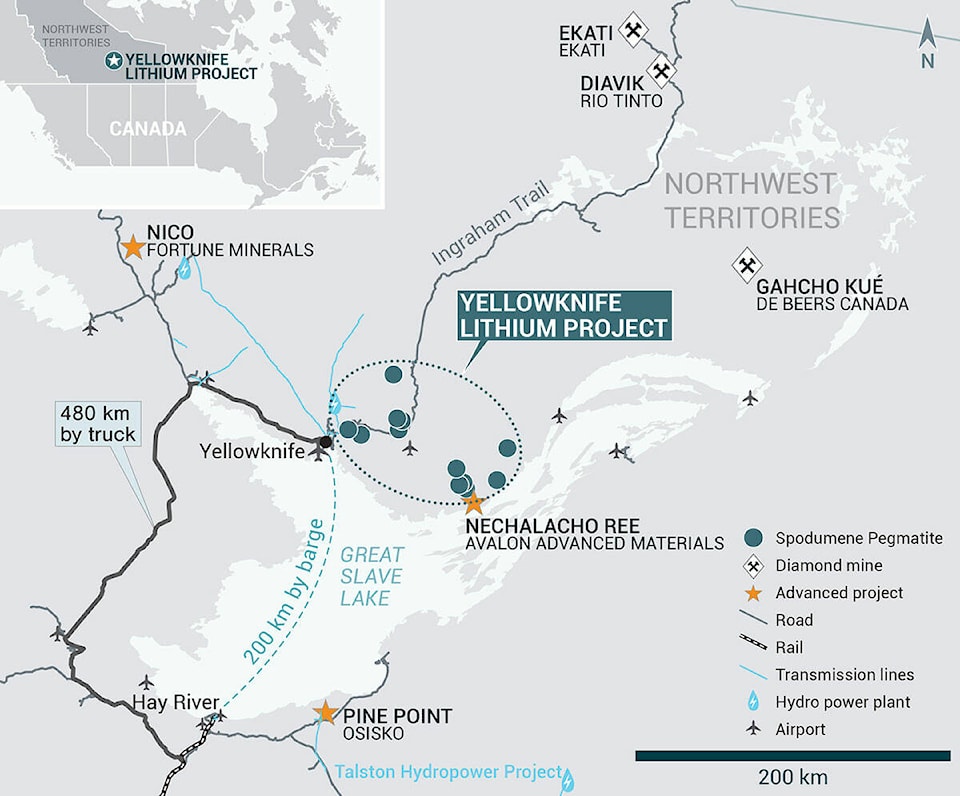Yellowknife’s economic outlook may appear grim as the territory’s three diamonds draw closer to closure, but one rare earths exploration company claims it might just be the catalyst for better days ahead.
April Hayward is the chief sustainability officer at Li-FT (pronounced “lift”). Although based in Vancouver, they’ve been doing exploration work in the NWT for almost a year now. Hayward went into detail on their results so far.
“We have drilled a total of 286 holes over the last year between the summer and the winter program we had, which is 49,547.5 meters of drilling,” said Hayward.
Hayward said Li-FT has a couple of projects in the NWT, one of which they call the “Yellowknife Lithium project,” which is taking place just outside the city, including one location just of Bighill Lake, she said.
Last winter, the company built a winter road across Pontoon Lake and onto Bighill Lake to access this location.
As the title suggests, the company is looking for lithium. To find it, Li-FT has identified 13 spodumene pegmatite locations in the territory, Hayward explained. Some are close to Yellowknife, some are further afield to the east.
Spodumene is a pretty-looking crystal that contains lithium. And so far, Li-FT’s results sound good.
“Of those 13 pegmatites that we think have some lithium in them, eight have already been drilled, and that includes seven along the Ingraham Trail,” Hayward said. She added they’re starting to see some “pretty promising” results, but are still in the exploration phase though.
Nothing is set in stone. Hayward added that Li-FT hasn’t done any economic studies either, and are still determining what their future in NWT looks like.
Next up on their to-do list is gathering more data, Hayward said.
“We’ve turned our attention more towards getting ready to, perhaps one day, enter an environmental assessment,” said Hayward. “We’ll be collecting things like water quality data, information on fish populations, and hydrology and water flows in the area.”
She added they’ll also be getting more background information on the socio-economic side of the territory, which will also feed into their environmental assessment.
Bringing a new mine into production isn’t exactly a speedy process. Hayward noted the average time from discovery to production of a mine is around 16 years.
That puts them on quite the time crunch. It’s a risk, Hayward said, considering what’s at stake.
“There’s a window of opportunity for bringing hardrock lithium into the global lithium market. And that’s what we have in the area,” she said. “The risk there of not doing this in a timely manner and moving the project forward in a timely manner, is that the technology to extract lithium from different sources is going to evolve very rapidly.”
She added that companies are trying to find novel ways of extracting lithium and novel sources of lithium.
“People are out looking for lithium and now like they’ve never been before, because about 80 per cent of the demand for lithium comes from electric vehicles,” Hayward said.
On April 25, Prime Minister Justin Trudeau and Ontario Premier Doug Ford announced that the Japanese automaker, Honda, will spend $15 billion to build four electric vehicle plants in Ontario.
“There’s been so many commitments made by governments around the world to switch off of vehicles that use fossil fuels and move over to a new (electric vehicle) era,” said Hayward. “And so people are out looking for lithium, and they’re really trying to innovate around ways to extract lithium.”
Li-FT has a rather ambitious schedule now, Hayward said. They could potentially start their environmental assessment process as early as 2025.
“And then it should take maybe a year after that, for the actual permitting process where you establish the specific licence and permit conditions under which you operate and all of your management plans and whatnot,” she explained.
If all goes well, Li-FT could start construction in 2029, potentially entering production in 2030, said Hayward.
In the meantime, she stressed the need for communication, especially with communities in the Northwest Territories.
“We really want to be transparent about our activities and what we’re up to,” said Hayward.
The future hasn’t always looked so bright for the NWT. If all goes well, they might still strike gold, or lithium, so to speak.
“This project has great potential to fill a really important economic gap in the Northwest Territories, and I think there’s a lot of concern about what will happen to the territory and to our communities with the closure of the (diamond) mines,” said Hayward.
“I think it’s important that people are aware of it and ask questions and have their concerns addressed early so that we can hopefully all work together to make sure we have a bright economic future in the territory.”
